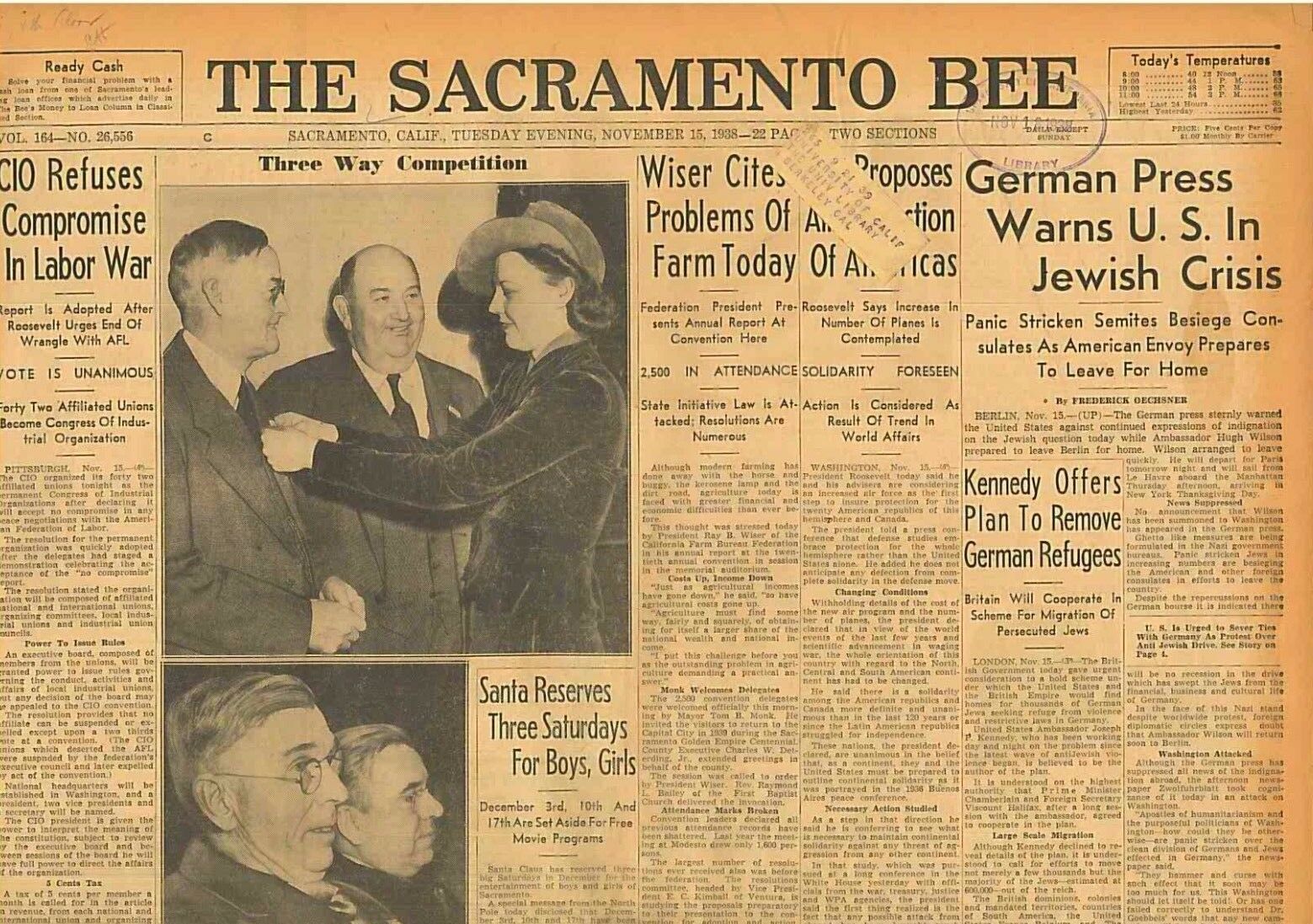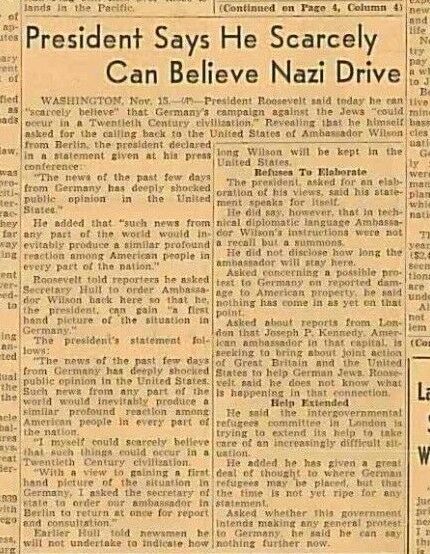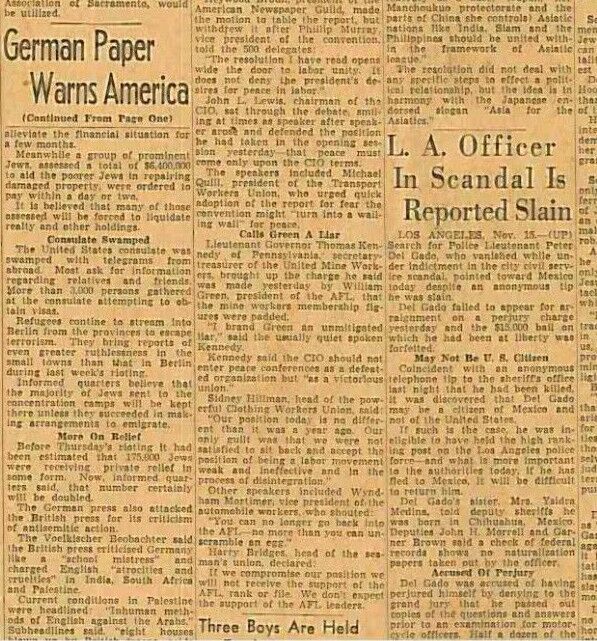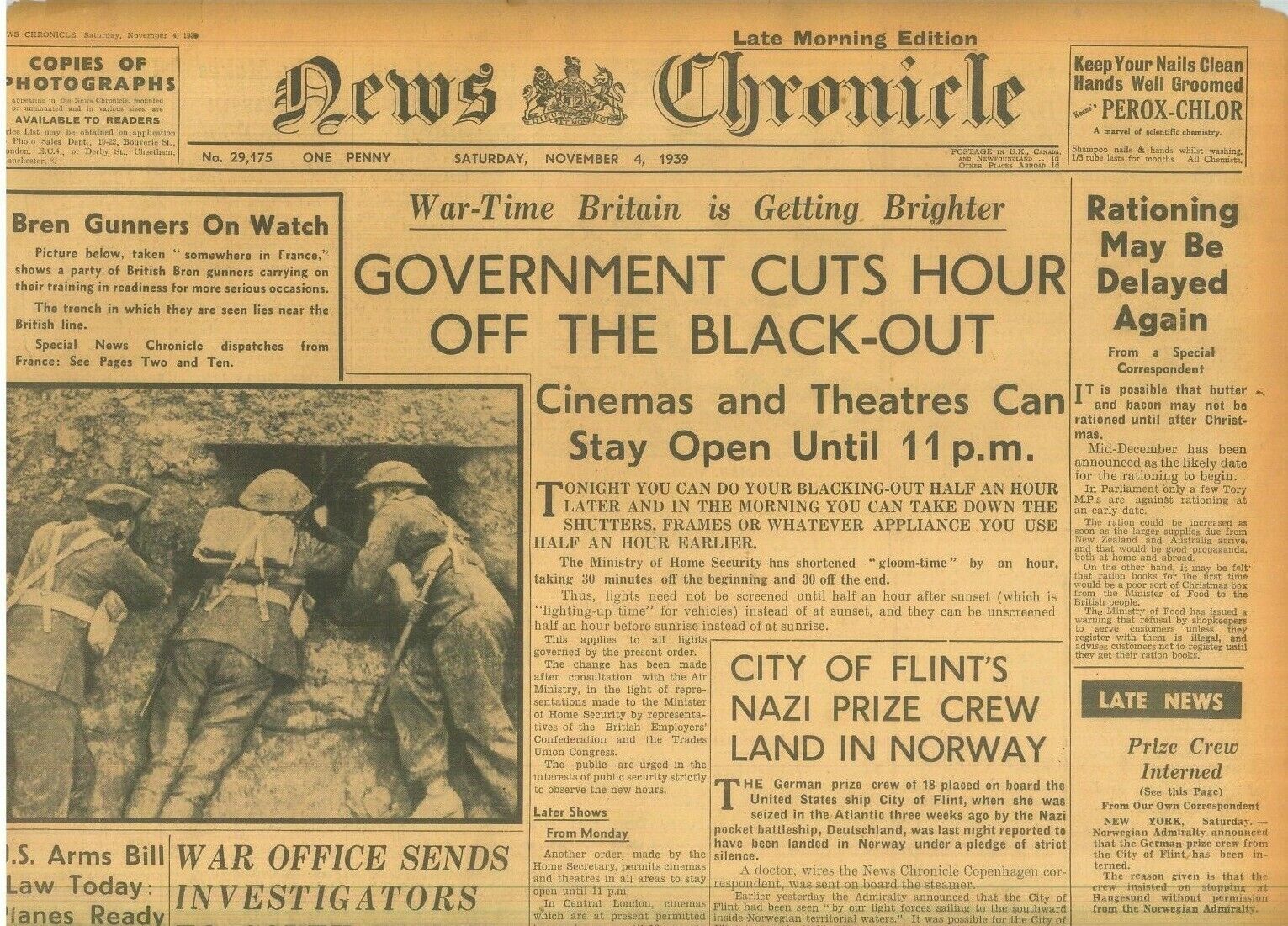-40%
Kristallnacht Night Broken German Press Warn US In Jewish Crisis Nov 15 1938 B17
$ 36.43
- Description
- Size Guide
Description
The Sacramento Bee.. November 15 193822 Pages
German Press Warns U.S In Jewish Crisis
President Says He Scarcely Can Believe Nazi Drive
Events Leading Up to Kristallnacht
What led to the Night of Broken Glass?
Hitler came into power in 1933 with a plan- to expand Germany’s rule and to completely annihilate the world’s Jews. The time up until, and even after, Kristallnacht was ripe with new laws and governmental policies that regulated Jewish life and persecuted the Jews in Germany, stripping them entirely of their freedom. Polish Jewish student Herschel Grynszpan was one of the many deeply affected and hurt by these discriminatory laws, most specifically laws that forced his family to emigrate from Germany, where they had lived nearly their entire lives. In order to express his anger and frustration and protest the persecution in Germany, Grynszpan acted out against the Nazis. His final action was to assassinate the German Secretary Ernst von Rath. This assassination was used as an excuse by Hitler and the Nazis to further persecute the Jews by dedicating an entire night to the destruction of Jewish properties, synagogues, and Jewish life itself. However, this reasoning begs the question: Is it really right to hold an entire people accountable for the actions of just one person?
Reproduction of the first page of an addendum to the Reich Citizenship Law of September 15, 1935. The Reich Citizenship Law was one of two legislative acts promulgated at a special session of the Reichstag in Nuremberg during the annual Nazi Party rally in 1935. Together they came to be known as the Nuremberg Laws and served as the basis for the exclusion of Jews from German society and for all subsequent anti-Jewish legislation enacted during the Third Reich. -USHMM, courtesy of National Archives and Records Administration, College Park
Up until this point, terror and violence had been the primary means of proliferating antisemitism and Jewish persecution. However, this method was largely unpredictable and unmanageable. Hitler had no way to control the means or the range of the Nazis’ terror techniques. Therefore, Hitler and his Cabinet enacted the Nuremberg Laws as a way to announce and spread antisemitism in an organized manner. This new anti-Jewish legislation was made official September 15, 1935, at the annual NSDAP congress at Nuremberg, thus acquiring the name the Nuremberg Laws. These regulations categorized Jews as members of a unique race, rather than members of a religious tradition. This gave false purpose to Jewish persecution, as it was now the Nazis’ goal to supposedly maintain the purity of German blood.
The new laws held several consequences. Marriage between Germans and Jews was now forbidden. More devastating, however, was that the Jews were no longer citizens of Germany. They were instead characterized as subjects of the German Reich, as they were not of German blood according to the Nazi laws, but yet lived under the protection of the Reich and were thus obligated to it. Because they were no longer considered German citizens, Jews no longer enjoyed any political rights, nor were they protected from the country’s judiciary system. Jews were basically left to the will of the state.
Eugenics poster entitled “The Nuremberg Law for the Protection of Blood and German Honor.” The illustration is a stylized map of the borders of central Germany on which is imposed a schematic of the forbidden degrees of marriage between Aryans and non-Aryans and the text of the Law for the Protection of German Blood. – USHMM, courtesy of Hans Pauli
In addition to the discriminatory legislation and actions described above, the Nazis also revoked Jewish privileges to hold public office, to vote, and to own rural property. German Jews were also made to pay double the taxes as other German citizens, due to their being considered ‘aliens’ in Germany.
The Nazis continued to use their flawed and irrational racial theory to further propagate discrimination against the Jews. On April 11, 1938, Hitler’s government made a decree stating their definition of “Aryan” and “non-Aryan.” A “non-Aryan” was considered anyone who descended from non-Aryan parents or grandparents, especially parents or grandparents who were Jewish. Each person was made to prove their “Aryan” descent through birth certificates, parents’ marriage certificates, and a series of questionnaires about genealogy. The law stated at the time: “A Jew is a Jew is a Jew,” meaning that qualification as a “non-Aryan” and the persecution executed by the Nazis extended down to the third generation.
Portrait of Herschel Grynszpan taken after his arrest by French authorities for the assassination of German diplomat Ernst von Rath. -USHMM, courtesy of Morris Rosen
The Polish government recognized what was going on in Germany and began to fear that Germany would expel Jews living in German who were Polish citizens and force them to return to Poland. The Polish government issued a decree stating that the citizenship of Poles living abroad would be annulled unless these Poles received a special stamp from Polish officials by October 31st. Without this stamp, Polish citizens would be refused re-entry into Poland.
The stamp was not given out, however, leaving approximately 50,000 Polish Jews without permission to re-enter the country. The German government learned that Poland would not allow their Jews to return, so Hitler ordered on October 27, 1938, that 12,000 Polish-born Jews be expelled from Germany. These Jews were given one night to leave Germany, with only one suitcase to carry their belongings. They were put on trains to the Polish border, and were dropped off at the station in Zbaszyn, without permission to enter either country. Four thousand Jews were eventually let into Poland, but at least 7,000 were forced to stay at the station in Zbasyn, without food, housing, money, or any information on what was to happen.
The parents and sister of 17-year-old Polish Jewish student Herschel Grynszpan were among those expelled from Germany, although his parents had lived in Hanover since 1914. Herschel was studying in Paris, but his sister sent him a postcard explaining their predicament, which he received on November 3rd. Furious, Grynszpan bought a pistol and some bullets on November 6th, and on November 7th, went to the German Embassy with a plan to kill the Ambassador.
Grynszpan did not get a shot at the Ambassador, but he did shoot the Third Secretary in the German Embassy in Paris, Ernst von Rath, who died two days later. This act opened the door for Hitler and the Nazis to further their campaign against the Jews. On November 8th, the German newspapers denounced Jews as murderers, blaming the Jewish people as a whole for the killing of von Rath. New anti-Jewish legislation was declared, which banned all Jewish newspapers and publications, suspended all Jewish cultural activities, and prohibited all Jewish children from attending “Aryan” state elementary schools.
Hitler found out about von Rath’s death on November 9th, while in Munich at a gathering of Nazi Party leaders. ii His Minister of Propaganda, Dr. Josef Goebbels, explained to him that violence against the Jews had already broken out, but Goebbels encouraged Hitler to allow further punishment of the Jews through more “spontaneous demonstrations” of violence. Hitler’s response is recorded in Goebbel’s diary:
“He decides: demonstrations should be allowed to continue. The police
should be withdrawn. For once the Jews should get the feel of popular
anger. … I immediately give the necessary instructions to the police
and the Party. Then I briefly speak in that vein to the Party leadership.
Stormy applause. All are instantly at the phones. Now people will act.”
iii
We have a collection of these stunning newspapers, book reviews and magazines from the 1920's 1930's 1940's 1950's 1960's 1970's for January, February, March, April, May, June, July August, September, October, November and December. Covering most dates in any given month.
We also have an extensive archive of American and Canadian newspapers, magazines and book reviews covering most of the United States.
Some of the titles include: New York Times, Post, Sun, Herald, Tribune, Journal of Commerce, Kansas City Star, Times, Christian Science Monitor, San Francisco Chronicle, LA Times, Washington Times, Star, Baltimore, WSJ and many more titles.
Canada titles include - Montreal Daily Star, Gazette, Standard, La Patrie, Toronto Mail & Empire, Daily Star
Please don't hesitate to contact us through eBay messaging with any specific dates or inquiries, we would be delighted to search for you.
PROFESSIONAL, HIGH QUALITY PACKING, AS WE STRIVE TO DELIVER YOUR ITEM IN THE BEST POSSIBLE CONDITION.











